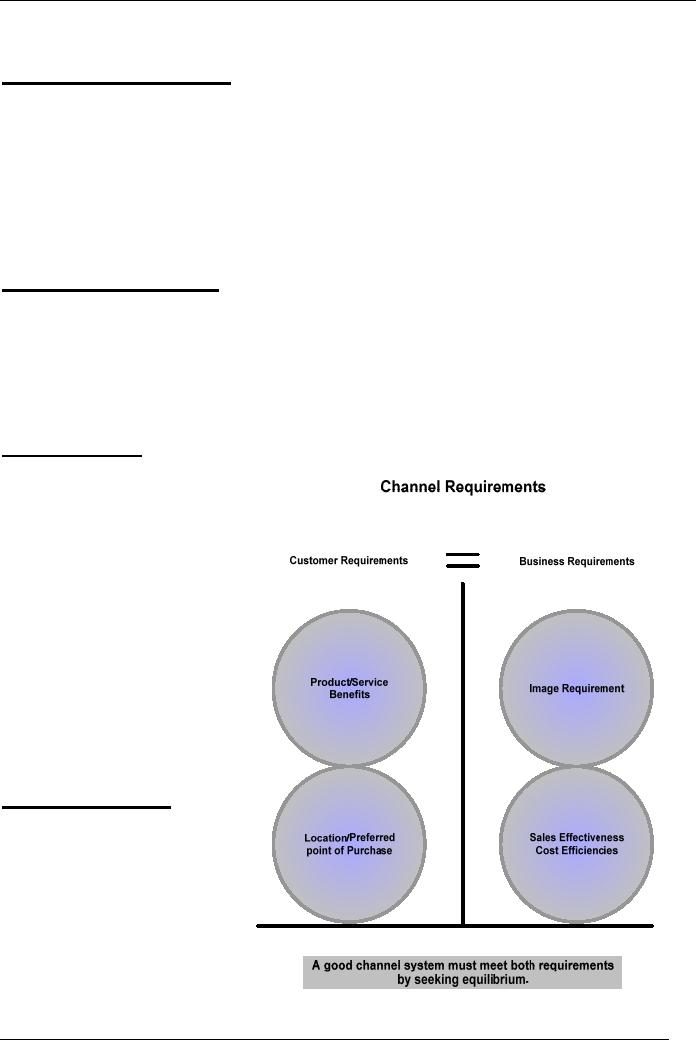 |

Brand
Management (MKT624)
VU
Lesson
30
CREATING
VALUE
Introduction
How
to create value through
building image and cost-efficiencies is
the starting point of
discussion
in this lecture. Having
known the fundamentals of
what lays the foundation
for
creating
the right channels for
the company, we shall take a
look at the amount of power
that
different
members of the channel enjoy. We
shall then see how
that affects the
negotiation
process
that goes on among different
members to make a channel system
function.
Value
thru image building
Companies
must be very careful in
choosing the channel that is
compatible with the
brand
picture.
They must pick up retailers
and dealers that are
compatible with the associations
the
brand
evokes and the persona the management
wants built.
Expensive
luggage, expensive perfumes,
race and mountain bikes,
expensive watches,
top-of-
the-line
consumer items like olive
oil, or those FMCGs that are
extended by selective
ingredients
are to be sold through
stores that have image
compatible with the persona
of the
products.
Selling these items at
stores incompatible in overall
appearance, inner d�cor,
and
retail
management practices will become difficult.
Actually, doing so may
damage the brand by
lowering
its image.
Value
thru cost-efficiency
A
company must establish a
channel system that assures
availability of products at the
locations
preferred
by customers. This holds
true for most of the
consumer items requiring an
extensive
outreach.
A widespread availability reduces cost;
the more you sell,
the lesser is the cost
of
transaction.
The more cost-efficient is
the system, the more
profitable is the business.
It
is the responsibility of the
business to develop channels
that are cost-efficient and at
the same
time
deliver all possible benefits to
customers.
Channel
power through brand power
Who
controls the channel is a
question that attracts
everyone's attention among
all members of
the
channel. Basically, it is the
ability of the brand to
offer value to customers
that drives power
all
along the channel. A brand
also accumulates power by offering
opportunities of growth to
intermediaries.
The source of power, mostly, is
the brand itself.
Members'
relationship with
brand
All
members of the channel have a
certain relationship with
the brand. Each one of
them
assumes
ownership of the brand that
dictates warehousing, selling, and
recovering the
investment
made on procuring the
brand.
It
is the job of management to identify
the value of relationships at
various stages of the
channel.
It is obvious that we are
considering an indirect channel
system that has
multiple
layers,
and it also goes without saying
that the more multi-layered
is the system the
more
diluted
would be power. The more
direct is the system, the
higher is the power for
the
manufacturer.
The
objective for the company
here is to make the right most decisions
for brand movement
through
different stages of the
channel without making
glaring mistakes that may
compromise
brand
value for customers.
118

Brand
Management (MKT624)
VU
Power
defined
"Social
scientists define power as the
ability to have others do
something that otherwise
would
not be done. In other words,
power is the ability to
cause a change1".
Power
in the context of distribution
channels is the ability of one
channel member to
influence
or
alter the behavior or
decision of the other
member2.
Example: A manufacturer may
influence
retailers
to acquire the most prime
space for its products.
Space acquired is power
exercised.
Inter-dependence
Because
of interdependence among all members, no one
member has the absolute
power. Some
have
more power and some have
less of it. For a new
manufacturer, distributors and
retailers
may
pose challenging demands
thus exercising their power
toward the pricing strategy.
It is
important
to view the relative degree
of power each member has and
weigh the advantage it
carries
before negotiating strategic
moves. Channel power,
therefore, is a function of
dependence
and a number of concepts and opportunities
emerge while we view
it.
Sources
of power
The
sources of power show us how
each member influences the
behavior of the other toward
its
goal
attainment. It is done in a few following
different ways3.
Rewards
Rewards
power is one member's ability to
give other something of
value.
Example:
A retailer offering shelf
space and point-of-sale support is of
value to a manufacturer.
By
offering these rewards, a
retailer may influence the
manufacturer's support, who in
turn,
may
promise better pricing,
promotional allowances, advertising,
extended payment terms
etc.
By
offering rewards in their
respective capacities, the two
are able to change each
other's
behavior.
If promises are fulfilled, the
relationships acquire more
credibility. Reward
power
becomes
a positive source of power.
Coercion
The
coercive power (compelling by
force) is exercised when one member
has the ability to
control
resources and change behavior of the
other. The member being
coerced knows that he
has
limited choice and therefore
accepts change of behavior; whenever,
what could have
been
rewards
are withheld.
Coercive
power ultimately leads to
channel conflict and therefore
should be avoided. It is
perceived
as force employed by the one
with an advantage. In other words, it is
exploitation.
There
is a natural tendency to resist
that.
Legitimate
power
It
is based on the belief that
one party is entitled to ask
for a certain behavior,
owing to its
reputation,
position, and role in the
market. Such beliefs are
held about manufacturers of
high
reputation
who are involved in the
development and production of goods
that surpass
customers'
expectations. Pharmaceutical companies
fall into this category. It
does not exclude
some
of the good consumer items companies and
any other that are
involved in scientific
developments.
This kind of power stems
also from the value systems of
other channel members
who
grant that status to the one of
power. It is highly
traditional.
Expert
power
This
power is based on a channel
member's superior knowledge and
information that he
has
about
his products. Example: A
manufacturer's sales force
may impart vital information
to
119

Brand
Management (MKT624)
VU
distributors
and retailers on merchandizing, inventory
control, promotional techniques,
and
latest
market trends etc. The
company wields power.
In
most of the cases power
results from a combination of
different factors of which
high brand
acceptance
and store acceptance are on top.
This implies that
manufacturers and retailers
are
generally
the ones who wield
power in most of the
cases.
How
do manufacturers and retailers end up
having more power in
proportion to other members
of
the trade is an interesting discussion
that gives the
answer.
Multi-brand
companies' power
Mega
brand companies and multi-brand
conglomerates are in a much
better position to
cut
better
deals with retailers. The
advantages of having different
brand portfolios come into
play
here
and offer the companies the
opportunity to deal from a position of
strength and, hence,
power.
Companies with lesser powerful brands
may not exert the
kind of influence wielded
by
multi-brand
companies.
Retailer
concentration and power
What
really should make businesses
prudent and pragmatic is the
mutual dependence.
This
dependence
is highlighted in case of growing
power of retailers. The balance of
power is
shifting
from manufacturers to
retailers4.
Retail store is the place where
final purchasing
action
takes
place. It has become a dynamic sector
which is uplifting itself in
appearance, growth,
intensity,
and innovation. The emergence of
chain stores is making
retail stores look more
and
more
credible. All those factors are
changing the landscape of
retailing with more power
to
retailers.
Because
of better management techniques and
marketing orientation, retailers can
give better
feedback
on buying patterns and criteria.
They can better measure the
sales relationship
with
shelf
space, location in the store,
effect of promotions etc., and
provide detailed and
minute
data
to manufacturers.
Companies
working very closely with
retailers can benefit from
that feedback that
provides
insights
into customer behavior and,
hence, can lead to improvements in the
brand-based
customer
model.
Convergence
of manufacturer and retailer
power
Manufacturers,
on the other hand, have a
better understanding of the
whole marketing
process
and
their product, which is a
result of extensive R&D and
investments. The perspectives of
both,
when converge, provide the
brand with better support,
which dictate that both
work
together
as partners, and not powerful
opponents.
Reaction
to retail power
Due
basically to the shift of balance of
power in retailers' favor,
manufacturers have started
thinking
of their own retail outlets.
Some are acting upon
this thought. By having your
own
outlets
the channel is not only
better controlled, it is owned. In
addition to better
profitability
and
power, the management process
becomes conflict-free offering
better opportunities
for
growth.
Retail
brand (store of the name)
becomes the product brand
and the brand-consumer
relationship
acquires a whole new
definition.
Take
a look at chain stores of
clothing (Hang Ten) and
shoes (Service and Urban
Sole) and you
will
notice the whole set-up is
created with brand
positioning, brand values, and
quality
proposition
in mind. Strategically, they
have a differentiation advantage. They
can express their
120

Brand
Management (MKT624)
VU
core
values in everything they
do, from d�cor to display of
the products. That is not
the case at
other
retail stores that sell
everybody else's brands.
Reaction
to distributor power
Manufacturers,
in certain cases, also decide to
become their own
distributors only to
avoid
being
subjected to established distributors'
power. The process could be
a little more
challenging
in the beginning owing to
high cost of learning. But, soon
after you are
comfortably
sitting on the learning
curve, you may be approached
by other manufacturers to
start
handling their distribution.
Distribution, in itself, becomes a
huge business line for
such
manufacturers.
If
you have a product meant
for an exclusive market,
getting into your own setup
makes more
sense
than if you want to
introduce a mass consumption
product.
Twin
focus and pragmatism
However,
it is obvious that retailers and
distributors play and will continue to
play well into
the
future
important roles. It is important
that manufacturers have a
twin focus both on
their
customers
(distributors and retailers) and
consumers (ultimate
consumers).
The
companies have got to be nimble and
quick in assessing changes
taking place in the
market
and
then deciding strategic
shifts. The objective here is to enhance
brand power, and use it
to
give
the company channel power
and sustain it.
Summary
- power
Power
basically stems from
the
value
of brand. It is shared by
all
Figure
38
members
of the trade. The
sharing,
however, is not
proportionate.
Depending on the
strategic
standing of various
members
stemming
from
different
reasons, different
levels
of
power are enjoyed by
those
members.
What is important is
that
all should work as
partners
and
see to it how the
power
wielded
by each of them can be
exercised
to enhance the value
of
the brand.
Channels
concluded
A
business may have
attractive
products
and services, but if it
cannot
deliver those to the
target
market
efficiently
and
effectively,
it will not succeed at
the
game of marketing.
Customers
have preferences for
products
and services in view of
benefits
along with
their
preference
for the place of purchase. Businesses
have the preference to
deliver effectively and
cost
efficiently; they also need to
build image.
121

Brand
Management (MKT624)
VU
Unless
there is an equilibrium between
the requirements of customers and
businesses, the
channel
system cannot be described as
optimal having potential to
leverage the brand. This
can
be
graphically illustrated.
Bibliography:
1.
Donald J. Bowersox and Bixby
Cooper: "Strategic Marketing Channel
Management";
McGraw-Hill
International Edition
(292)
2.
Punam Anand and Louis W. Stern: "A
Sociopsychological Explanation for
Why
Marketing
Channel Members Relinquish Control";
Journal of Marketing
Research,
22;4
November 1985 (365-376)
3.
Donald J. Bowersox and Bixby
Cooper: "Strategic Marketing Channel
Management";
McGraw-Hill
International Edition
(294-297)
4.
Geoffrey Randall: "Branding A
Practical Guide To Planning
Your Strategy";
Kogan
Page
(37)
Suggested
readings:
1.
Scot M. Davis: "Brand Asset
Management Driving Profitable
Growth through
Your
Brands;
Jossey-Bass, a Wiley Imprint
(181-197)
2.
Roger J. Best: "Market-Based Management
Strategies for Growing Customer
Value
and
Profitability"; Prentice Hall
(271-294)
122
Table of Contents:
- UNDERSTANDING BRANDS – INTRODUCTION:Functions of Brand Management, Sales forecast, Brand plan
- INTRODUCTION:Brand Value and Power, Generate Profits and Build Brand Equity
- BRAND MANIFESTATIONS/ FUNDAMENTALS:Brand identity, Communication, Differentiation
- BRAND MANIFESTATIONS/ FUNDAMENTALS:Layers/levels of brands, Commitment of top management
- BRAND CHALLENGES:Consumer Revolt, Media Cost and Fragmentation, Vision
- STRATEGIC BRAND MANAGEMENT:Setting Objectives, Crafting a Strategy, The Brand Mission
- BRAND VISION:Consensus among management, Vision Statement of a Fast Food Company, Glossary of terms
- BUILDING BRAND VISION:Seek senior management’s input, Determine the financial contribution gap
- BUILDING BRAND VISION:Collect industry data and create a brand vision starter, BRAND PICTURE,
- BRAND PICTURE:Brand Value Pyramid, Importance of being at pinnacle, From pinnacle to bottom
- BRAND PERSONA:Need-based segmentation research, Personality traits through research
- BRAND CONTRACT:The need to stay contemporary, Summary
- BRAND CONTRACT:How to create a brand contract?, Brand contract principles, Understand customers’ perspective
- BRAND CONTRACT:Translate into standards, Fulfill Good Promises, Uncover Bad Promises
- BRAND BASED CUSTOMER MODEL:Identify your competitors, Compare your brand with competition
- BRAND BASED CUSTOMER MODEL:POSITIONING, Product era, Image Era, An important factor
- POSITIONING:Strong Positioning, Understanding of components through an example
- POSITIONING:Clarity about target market, Clarity about point of difference
- POSITIONING – GUIDING PRINCIPLES:Uniqueness, Credibility, Fit
- POSITIONING – GUIDING PRINCIPLES:Communicating the actual positioning, Evaluation criteria, Coining the message
- BRAND EXTENSION:Leveraging, Leveraging, Line Extension in detail, Positive side of line extension
- LINE EXTENSION:Reaction to negative side of extensions, Immediate actions for better managing line extensions
- BRAND EXTENSION/ DIVERSIFICATION:Why extend/diversify the brand,
- POSITIONING – THE BASE OF EXTENSION:Extending your target market, Consistency with brand vision
- DEVELOPING THE MODEL OF BRAND EXTENSION:Limitations, Multi-brand portfolio, The question of portfolio size
- BRAND PORTFOLIO:Segment variance, Constraints, Developing the model – multi-brand portfolio
- BRAND ARCHITECTURE:Branding strategies, Drawbacks of the product brand strategy, The umbrella brand strategy
- BRAND ARCHITECTURE:Source brand strategy, Endorsing brand strategy, What strategy to choose?
- CHANNELS OF DISTRIBUTION:Components of channel performance, Value thru product benefits
- CREATING VALUE:Value thru cost-efficiency, Members’ relationship with brand, Power defined
- CO BRANDING:Bundling, Forms of communications, Advertising and Promotions
- CUSTOMER RESPONSE HIERARCHY:Brand-based strategy, Methods of appropriations
- ADVERTISING:Developing advertising, Major responsibilities
- ADVERTISING:Message Frequency and Customer Awareness, Message Reinforcement
- SALES PROMOTIONS:Involvement of sales staff, Effects of promotions, Duration should be short
- OTHER COMMUNICATION TOOLS:Public relations, Event marketing, Foundations of one-to-one relationship
- PRICING:Strong umbrella lets you charge premium, Factors that drive loyalty
- PRICING:Market-based pricing, Cost-based pricing
- RETURN ON BRAND INVESTMENT – ROBI:Brand dynamics, On the relevance dimension
- BRAND DYNAMICS:On the dimension of knowledge, The importance of measures
- BRAND – BASED ORGANIZATION:Benefits, Not just marketing but whole culture, Tools to effective communication
- SERVICE BRANDS:The difference, Hard side of service selling, Solutions
- BRAND PLANNING:Corporate strategy and brands, Brand chartering, Brand planning process
- BRAND PLANNING PROCESS:Driver for change (continued), Brand analysis
- BRAND PLAN:Objectives, Need, Source of volume, Media strategy, Management strategy